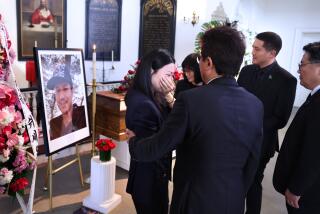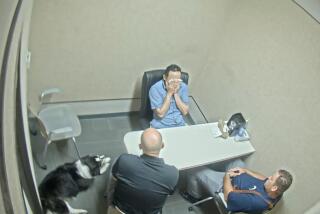Under Her Spell? : Paul Lozano’s family claims he killed himself over the mother-son therapy his psychiatrist used--and over their sexual relationship. But the doctor says that the therapy was appropriate and denies having an affair.
- Share via
BOSTON — As a 3-year-old, Paul Lozano amazed his Mexican immigrant parents by teaching himself to read in English. Announcing that his favorite writer was Dr. Seuss, he promptly devoured every book by the author that he could find.
So when Lozano’s oldest sister discovered books by Dr. Seuss among his possessions after he killed himself a quarter-century later, the memory carried bitter irony. This time, the volumes bore tender inscriptions to the 28-year-old Harvard Medical School student from his psychiatrist, Dr. Margaret Bean-Bayog.
“To the baby, Love, Dr. B,” read one typical entry.
In a case that has sent tremors through this city’s tightly knit psychiatric community, the Lozano family has accused Bean-Bayog--who treated Lozano for depression for four years and, the family says, engaged in a sexual relationship with him at the same time--with causing the young man’s death. Family members filed suit late last month, seeking unspecified damages.
The legal action puts an unusual spin on the increasingly familiar story of sexual involvement between psychiatrists and their patients. According to Andrew C. Meyer Jr., the Lozanos’ lawyer, only 2% of such claims involve female psychiatrists and male patients.
Bean-Bayog, a 48-year-old Harvard Medical School professor, emphatically repudiates the suggestion that she mistreated Lozano or engaged in a prolonged, steamy sexual liaison.
“I deny that I had sexual relations with Paul Lozano,” the psychiatrist, who has been married to a fellow physician since 1984, insists in a written statement released through her attorney. Moreover, Bean-Bayog contends that she feels “raped” by the uproar.
“No male therapist,” she declares, “has ever been the subject of such an assault.”
But the Lozano family says gender has nothing to do with a case made even more notable by a bilingual guide to torture devices and by hundreds of pages of graphically erotic material--which Bean-Bayog acknowledges that she wrote--found in the dead man’s apartment.
“She’s a monster,” charges Lozano’s sister, Pilar Williams, a critical care nurse in El Paso, Tex., and the family’s unofficial spokeswoman. “She destroyed my brother.”
Along with anger, sadness and salaciousness seem to hover over this case.
There is the tragedy of a promising medical student, who died from 75 self-administered injections of cocaine on April 2, 1991. There is the controversy over Bean-Bayog’s use of a treatment called regression therapy that left Lozano literally clutching a security blanket and, in the voice of a 3-year-old, referring to his psychiatrist as “Mom.”
There are the voluminous and often sadomasochistic fantasies, written by Bean-Bayog and released by Meyer, which are filled with references to bondage, rape, torture, degradation and humiliation. “I look radiant,” one passage begins, “not at all like someone who had the daylights beaten out of them and is expecting more of the same.”
And there are the “Handy, Multipurpose, Emergency and Reference” flash cards that Bean-Bayog hand-wrote for Lozano.
“Run over these cards every day until you know them all by heart and are starting to believe them,” the flash cards read. “I’m your mom, and I love you and you love me very, very much. Say that 10 times.”
Says one member of the Boston psychiatric community, speaking on the condition of anonymity: “This is as tragic as it comes. It doesn’t get any sadder than this.”
When Harvard’s health service referred him to Bean-Bayog in July, 1986, Lozano was 24 years old and a third-year medical student.
The youngest of six children, he was a high school honor student and cross-country runner who had attended West Point for two years before transferring to the University of Texas, El Paso, to be closer to home.
At Harvard, Lozano was enrolled in a rigorous joint M.D.-Ph.D. program. Friends and family members say he welcomed the challenge, but that he was lonely and often felt out of place in the school’s socially and academically elite atmosphere.
“Many times he thought his co-students were thinking of him as some kind of token Mexican,” says Williams. “It’s a class thing. There are some very wealthy people at Harvard. It can be a cold, hard place.”
Lozano’s childhood in a “very close and very loving” family in Upper Sandusky, Ohio, made the adjustment especially difficult, Williams believes. His only problem growing up, his sister says, “was that he suffered from the boy-genius syndrome. We doted over him.”
Dr. Thomas W. Watkins, the family pediatrician in Ohio, remembers the Lozanos as “fun to treat” because “they were always laughing and joking, and they were so pleasant to have in the office.” Other than such afflictions as acne and strep throat, “nothing spectacular, unusual or bizarre” distinguished Lozano or his family, Watkins recalls.
But Bean-Bayog says her treatment revealed that Lozano experienced “horrendous childhood abuse” and that as a boy he attempted suicide several times. The contention is one of several key disagreements raised by the lawsuit and was a topic that was analyzed by Bean-Bayog and other therapists during Lozano’s numerous hospitalizations for depression.
In fact, discharge papers issued in the fall of 1986 after Lozano was treated as an in-patient at McLean Hospital in suburban Boston seem to support Bean-Bayog’s conclusions. Lozano “describes a childhood history of abuse by his older siblings and perhaps by parents,” wrote Dr. Frances Frankenburg, who practices at McLean.
Yet four years later, Lozano would tell another psychiatrist, Dr. William Barry Gault, that the idea that he was abused as a child was “utterly without a basis in reality.” Blasting Bean-Bayog for “mismanagement” of Lozano’s problems, Gault’s report notes that Lozano asserted that Bean-Bayog had masturbated in front of him during a therapy session.
In addition to the lawsuit, Gault’s allegation of sexual misconduct was a factor in a rare emergency hearing last week in which the Massachusetts Board of Medical Registration considered revoking Bean-Bayog’s license. After more than three hours of closed-door testimony by Bean-Bayog, the board faulted her “unconventional method” of applying regression therapy in this case but allowed her to continue practicing.
Nevertheless, the board ruled that Bean-Bayog had provided “substandard care” to Lozano, in part because “during the course of treatment . . . (she) wrote explicit fantasies which may have related to Paul Lozano. Her failure to terminate or otherwise address these fantasies did not conform to the standards of accepted medical practice.”
Amy Stromsten, a Boston-area social worker, said in an affidavit filed late last week that in a 1990 teaching session for other mental-health specialists, Bean-Bayog freely discussed her sexual attraction involving a Mexican-American medical student she was treating.
Stromsten says she told Bean-Bayog that she knew the patient was Lozano because she had treated him in the course of one of his hospitalizations. According to Stromsten, she challenged Bean-Bayog to “stop describing her sexual fantasies” in front of the group, and when Bean-Bayog refused, she walked out.
Later, according to Stromsten’s affidavit, Lozano told her he felt “ashamed, embarrassed, dirty” about his sexual relationship with his psychiatrist. Stromsten says he called the relationship “kinky” but continued it because “he wasn’t paying her very much.”
Whether a sexual relationship between the two actually existed may never be known. But one psychiatrist who has reviewed the case suggests that Lozano and Bean-Bayog may have developed a “fatal regression” attraction to one another, and that in some strange way, their fantasies may have become intertwined.
Lozano, who had a winning smile and an athletic build, was smart, intellectually curious and 20 years younger than Bean-Bayog; she, by contrast, was the exotic older woman--a WASP psychoanalyst with a national reputation.
Lozano’s family maintains that Bean-Bayog reduced her patient to childlike dependency by therapeutically regressing him to the emotional age of 3. Urging him to distance himself from his biological family, the Lozanos contend, Bean-Bayog encouraged him to refer to her as “Mom.”
If Lozano was sexually abused as a child, Stromsten says, “then regression therapy would be absolutely counterindicated.” In cases of sexual abuse, she and others say, “the last thing in the world you would do is retraumatize someone by regressing them. That would be heinous.”
But just as Bean-Bayog stands firmly by the validity of her treatment, she explains other disputed aspects of the case. The sexually explicit materials represent her own fantasies but were never acted out and were intended for her eyes only, Bean-Bayog told the licensing board. She contends that Lozano broke into her office and stole them, although no theft was reported to police.
Williams, who says it took three large shopping bags to remove the erotic writings from her brother’s apartment, notes that she also came across a series of letters and postcards sent to Lozano by Bean-Bayog while she was on vacation in the Philippines in 1987 with her husband.
“This drives me nuts. I miss you,” Bean-Bayog writes in one such dispatch. “I miss all of you.”
All the missives are signed “Love, Dr. B,” and one makes reference to “Bean-Bear,” a stuffed animal that Lozano’s family says the psychiatrist gave him.
Through her attorney, Bean-Bayog says the cards and letters were dictated by Lozano before she left on vacation to help ease his fears about separation from her.
What pushed Lozano over the edge was Bean-Bayog’s termination of the therapeutic--and perhaps personal--relationship, Williams believes.
Bean-Bayog’s only statement on her patient’s death is terse: “It is unfortunate and tragic that Mr. Lozano took an accidental cocaine overdose.”
Bean-Bayog has asserted that Lozano habitually misused alcohol and drugs, although others who knew him dispute that. Autopsy records show that he first deadened his arms with an anesthetic before injecting himself with cocaine.
“He wasn’t getting high,” says Stromsten. “He was getting dead.”
Meyer, the Lozanos’ lawyer, says the extent and degree of the contradictions are what make the case so disturbing.
“The whole thing is just wild to me,” Meyer says. “Except that someone died in the end.”
More to Read
Sign up for our Book Club newsletter
Get the latest news, events and more from the Los Angeles Times Book Club, and help us get L.A. reading and talking.
You may occasionally receive promotional content from the Los Angeles Times.










